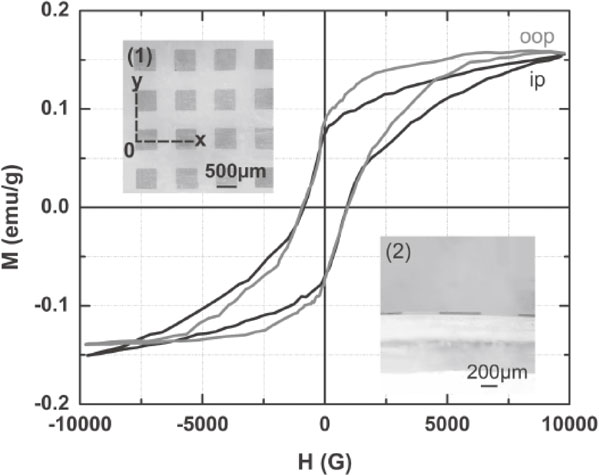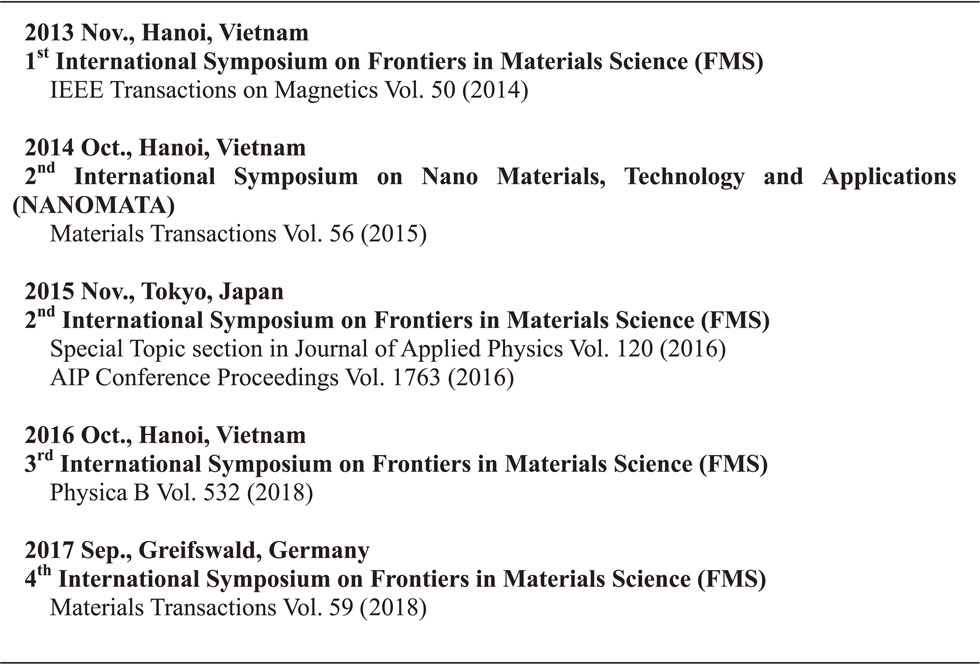2020 Volume 61 Issue 12 Pages 2435-2441
2020 Volume 61 Issue 12 Pages 2435-2441
A current research trend for nanostructured functional materials and their applications are summarized in this paper, for which a recently published special issue in Materials Transactions, Vol. 59, No. 7, is mainly surveyed here. Among the progresses of the functional materials, several important topics were covered in this special issue, which are advanced atomic or nano-meter scale analysis, advanced ab initio simulations, highly correlated electron system, advanced spectroscopy and advanced processing. In addition, contents of some related special issues are introduced.
The materials with desired properties such as magnetic, electric and optical properties for some specific applications are called functional materials, which have gained great attention in the world. As physical properties of the functional materials are sensitive to changes in the structural arrangements in nano-meter or subnano-meter scale including the crystal structures and atomic arrangement in an atomic scale, the nanostructured functional materials and their applications have been extensively studied.
Although there are plenty of publications in the field of the functional materials, that have appeared in Materials Transactions, we have just started collecting the selected papers in the first special issue in Materials Transactions, Vol. 56, No. 9, with a title of Nanostructured Functional Materials and Their Applications was published in 2015,1) which included 40 excellent papers mainly selected from the international symposium, 2nd International Symposium on Nano Materials, Technology and Applications (NANOMATA) held in Hanoi in Nov., 2014. This symposium provided a forum for scientists from all over the world to meet and exchange new ideas, perspectives, experiences, and research results, as well as to strengthen collaborations and facilitate new opportunities to expand the materials science community in Southeast Asia. Four parallel sessions with subtitles as Nanostructured Magnetic Materials, Advanced Optoelectronic Materials and Applications, Functional Magnetic and Electric Materials and Colloids and Polymers, Nano-biosystems were settled in the symposium. There were more than 150 presentations consisting of 120 posters and 34 oral talks, including 18 invited and 2 plenary talks. The proceedings as a special issue of Materials Transactions covered a wide area of the functional materials and were divided into 6 research areas, which are magnetic materials,2–8) functional oxide materials,9–17) nano materials,18–24) optical materials,25–28) soft-matter29–32) and analysis and computational materials science.33–41) After a success of the first special issue in the Materials Transactions, a second special issue was planned to be published again in Materials Transactions, which was realized as Vol. 59, No. 7, in 2018.42) This second special issue was related to the 4th International Symposium on Frontiers in Materials Science (FMS) held in Greifswald, Germany, in September, 2017, from which selected papers were included. A series of FMS was focusing upon the cutting-edge nanostructured functional materials and their applications. The first FMS was held in Hanoi in 2013, from which 38 excellent contributions focusing upon the magnetic materials were published in a special issue in IEEE Transactions on Magnetics, Vol. 50, No. 6, in 2014.43,44) This special issue covered the following topics: magnetism in solids,45,46) magnetic materials,47–75) magnetic recording and information devices,76) applied magnetism and phenomena,77,78) magnetic measurements and instrumentation79) and superconductivity magnetic devices and applications.80–82) The second FMS was held in Tokyo in 2015, from which 26 selected papers including one perspective article83) were published in Journal of Applied Physics,84) Vol. 120, No. 14, in 2016, as a special topic section “cutting edge physics in functional materials”85–109) together with AIP Conference Proceedings Series,110) Vol. 1763, in 2016. The later proceedings included 27 peer-reviewed papers, which covers broader area than the former special topic section in J. Appl. Phys. such as magnetism and nano-structured magnetic materials,111–121) functional materials,122–125) theoretical and computational materials science126–130) and nano-scale materials characterization.131–137) The third FMS was held again in Hanoi in 2016, from which 42 selected papers related to the condensed matter physics were published in a special issue of Physica B,138) Vol. 532, in 2018. There are 3 divisions in the special issue, which are structural, mechanical and thermal properties of condensed matters,139–154) electronic structure, electrical and magnetic properties of condensed matters155–171) and optical properties of condensed matters.172–180)
In the second special issue of a series of “Nanostructured Functional Materials and Their Aplications”42), 15 cutting-edge researches for nanostructured functional materials are included, which were divided into the 5 categories: Nanostructure analysis, Advanced ab initio simulations, Nanomaterials with highly correlated electron systems, Advanced spectroscopy and Advanced processing of nanomaterials. In the first category of the Nanostructure Analysis, two papers were published, both of which were done with transmission electron microscope for metallic alloys. The local atomic configuration of amorphous Fe–Si–B alloys were investigated by pair-distribution-function analysis using electron diffraction, which were compared with those of a metastable phase, σ-phase, formed during crystallization in the first paper by Hirata.181) Figure 1 shows (a) bright-field image of Fe78Si9B13 annealed at 763 K for 0.5 h, (b) electron diffraction pattern from (a), (c) [001] projected structure of σ-phase and (d) simulated electron diffraction pattern of σ-phase. After the analysis of the crystal phase, pair-distribution-function analysis of both crystalline and amorphous phases were carried out. From such analysis, he found a structural similarity, not only at short range but also at medium range up to 1.0 nm, between amorphous and σ-phase Fe–Si–B systems. In the second paper, quasicrystal structures of Mn–Si–V alloys were studied by Nakayama et al.182) Both of which are not simple crystal structure analysis, but they are beyond such analysis by the use of the electron diffraction technique. It is expected that such investigations can establish a new field of the nanostructured materials with more complicated structure of solids than crystals. In the second category of the Advanced ab initio Simulations, two excellent researches were presented. A new method with consideration of a multi-electron effect for the analysis of L-edge X-ray absorption spectra was given in the first paper by Urasaki and Ikeno,183) which is quite useful to know the local structures of nanostructured materials including 3d transition metals. The second paper showed the results on the ionic conduction of Li ions in LixFePO4 olivine using the first principles calculation within the density functional theory by Kishida et al.,184) in which transition of Li site occupation with the smallest energy fluctuation was searched through graph theory and trajectories of Li ions were calculated by the nudged elastic band method. Resultant migration path of Li ions in LixFePO4 is shown in Fig. 2. As it is very difficult to determine such migration path experimentally, such simulations play important role for the development of the Li ion batteries. The third category of the Nanomaterials with Highly Correlated Electron Systems includes three advanced studies. The first paper is for the crystal structure and magnetic property investigations of La–Sm–Fe–Si and La–Tb–Fe–Si systems by Vuong et al.185) They observed XRD patterns for the crystal structure analysis and the temperature dependent magnetization of La0.8R0.2(Fe0.88Si0.12)13, where R = Sm or Tb. The observed magnetization at 100 Oe of La0.8R0.2(Fe0.88Si0.12)13 are shown in Fig. 3. From these analysis, significant increase of Currie temperature and magnetic entropy change were observed. In the second paper, enhancement of critical current density in the Bi–Pb–Sr–Ca–Cu–O superconductor by Na incorporation was studied by Tran et al.186) In the third paper, theoretical study on dynamical susceptibility and elementary excitations in monolayer ferroic films was conducted using Hiesenberg model by Nguyen et al.187) In the fourth category of the Advanced Spectroscopy, two cutting-edge works with advanced spectroscopic techniques were reported. In the first paper, a role of gap size and a density of the plasmonic random gold nano-sized islands for surface-enhanced Raman spectroscopy (SERS) were investigated by Nguyen et al.188) Influence of the coverage by Au nanoparticle on the SERS was studied as shown in Fig. 4. The SERS intensity increased as decrease of the gap size. In addition, it was found that the SERS intensity depended on the density of nanogaps as well as the shapes of the nanoparticles of the network. Interaction of carboxylic acid headgroups of arachidic acid (AA) monolayers with trivalent ions Fe3+ and La3+ was studied using vibrational sum-frequency generation (VSFG) spectroscopy by Nguyen et al.189) In the fifth category of the advanced processing of nanomaterials, six attractive studies were summarized. First work is for the fabrication of micron-sized magnetic materials by ink-jet printing by Cuong et al.190) They synthesized squared magnetic patterns on the substrate as shown in the inset(1) in Fig. 5 and observed the magnetic property of such patterns. This kind of the basic researches has important meanings for the industrial application, since the inkjet process is a simple and low-cost fabrication method. Second paper describes synthesis of hybrid nanomaterial of Fe3O4/polyaniline, whose properties were carefully examined, and its ability of removing arsenic in wastewater was studied by Trung et al.191) In the third one, fabrication of Ag nanoparticles by the electrical spark discharge method and its application for restraining aspergillus Niger was investigated by Tseng et al.192) Fourth paper reported an investigation of nanosized Ag particles using graphene quantum dots by Hoang et al.193) Synthesis of ZnTiO3 and Ag/ZnTiO3 was reported in the fifth paper by Anh et al.,194) in which their antibacterial performance was also studied. The sixth paper by Nguyen et al. showed photoactivity of reducing graphene oxide and titanium dioxide composite for cinnamic acid degradation.195)

(a) Bright-field image of Fe78Si9B13 annealed at 763 K for 0.5 h, (b) Selected electron diffraction pattern obtained from the region of (a), (c) [001] projection of the sigma phase structure, and (d) Simulated electron diffraction pattern of the sigma phase structure. A thickness of the structure model was 4.8 nm. (Fig. 1 in Ref. 181))

Interstitial sites along migration path in a 1 × 2 × 1 super cell of LixFePO4. In the most stable structures, lithium ions occupied site a for x = 0.125, sites a and d for x = 0.25, sites a, b, e, and f when x = 0.5, sites a, b, c, d, e, and f when x = 0.75. Sites from i to p were unstable and occupied only in the transition state of ionic conduction. Arrows indicate a candidate of migration path of Li ion obtained by graph theoric minimum energy path finding at x = 0.125, 0.25, 0.75. (Fig. 5 in Ref. 184))

The dependence of magnetization on temperature in La0.8R0.2(Fe0.88Si0.12)13 compounds (R = Sm and Tb) at H = 100 Oe. (Fig. 2 in Ref. 185))

Influence of the AuNP coverage on the SERS intensity. Converted SEM images of the Samples A (a) and B (b) with nearly the same coverage (∼60%) together with the FDTD simulations of the distribution of the electromagnetic field over Samples A and B under the excitation of a monochromatic light with wavelength of 632.8 nm, respectively, presented in the same color bar. (c) Comparison of the SERS intensity of Samples A and B. The spectra are shifted in the vertical direction for clarity. The insets show the field enhancement at the typical gaps of Samples A and B, respectively. (Fig. 4 in Ref. 188))

Magnetic hysteresis curves of squares. Inset: (1) surface and (2) cross-section images of squares. (Fig. 3(a) in Ref. 190))
In summary, recent trends in nanostructured functional materials and their applications were introduced in this paper by the survey of the special issues related to the international symposia that we organized between 2013 and 2017, which are summarized on Table 1. This field covers a wide area of the materials science, then there are many papers not included in this paper. However, one aspect of the cutting-edge areas of the nanostructured functional materials can be covered by the current collections. We will continue the related international symposia and publish special issues to report the progress of the studies in nanostructured functional materials and their applications.

This work was partially supported by the Joint Research Center for Environmentally Conscious Technologies in Materials Science (Grant No. JPMXP0618217637) at ZAIKEN, Waseda University.